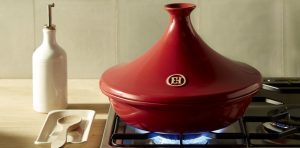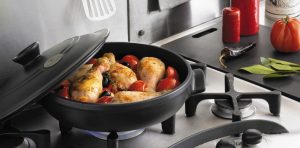Emile Henry cookware has been produced in Burgundy, France, for more than 170 years. To this day, this family-owned-and-operated company produce their beautiful Emile Henry ceramics from non-treated, high-fired Burgundy clay, with each piece signed by the worker who made it! In a world of chemicals and highly processed foods, Emile Henry ceramics naturally enhance flavours and aromas: from the base material through to the glaze, everything in their production is 100% natural, a fact which is mirrored by their earthy-inspired colour palette.
Whether it’s an Emile Henry tagine, utensils or tableware, you won’t find lead, cadmium or nickel in their products. Rather than chemical non-stick coatings, they utilise highly resistant glazes which allow cooking with minimal amounts of fat and which are easy to clean. Advocates of delicate cooking, Emile Henry Flame ceramics heat as much as cast iron but then act as a heat diffuser rather than conductor, making very high temperatures unnecessary. This means you cook your ingredients gently, food doesn’t burn and the flavours and vitamins are kept intact.
HISTORY
1848, The Discovery
A young potter, Jaques Henry discovered the world of ceramics in a small workshop in Marcigny, a village in his native Burgundy. He developed a real passion for the art of Earth and Fire.
1850, On The Road
When he was 20, he took off for a year with his ‘National passport’, and travelled the roads of France to meet other, more experienced, potters. He wanted to learn from other people’s experience and develop his savoir-faire as a ceramist. After one year, his dream became possible: offer the best and most beautiful pottery to the homes of his native Burgundy.
1870, The First Workshop
Jugs, terrines and soup tureens came to life in his hands, and in a few years he created a workforce of around 20 people. Jacques passed on to his son Paul a workshop which had a rich savoir-faire and was full of passion.
1900, Conquering Paris
Paul shared his father’s passion and quickly exported his creations to Paris. Customers were enthusiastic, and pottery from La Maison Henry was soon to be found on all the best Parisian tables.
1911, The Ruffled Pie Dish
The Ruffled pie dish designed by Paul was a great success, with its smooth lines and attractive shape: it soon became the symbol of the Company.
1922, A Strong Workforce
The workshop suffered during the two World wars, due to the lack of labour. Paul’s son, Emile, returned from the war in 1922 determined to get the workshop and its workforce back on its feet.
1955, Expansion
An Artisan engineer in a rapidly expanding company, Maurice set about modernising the production techniques while retaining the authenticity of the handcrafting skills. Along with his son Jacques, they wanted to offer each home the possibility to cook in highly resistant, attractive ceramic made using new technologies.
1982, A Tribute
As a tribute to his grandfather, Jacques changed the name of the company to Emile Henry, as a symbol of the passion which has been handed down from generation to generation, a passion for Earth and Fire and a continuation of authentic values.
1983, In Detail
Amateur gourmet, Jacques used his training as an engineer to design dishes which made cooking easier, paying attention to details such as the size and weight, adding handles or ridges in the bottom … Everything is studied in the smallest detail. For this, he created an in-house laboratory for Research and Development.
1986, Creating Colours
After much research, the Company created the first colourful dishes for use in the oven. It was a breakthrough for kitchens across the country!
1989, The Pie Dish
The colours helped to attract more and more customers all over the world. Pleasure and Cooking merged and the ‘Pie dish’ became an icon piece in American kitchens.
2005, Flame Ceramic
The Tagine, designed by Jacques, is born. It became the centrepiece of a new ceramic which was baptised ‘Flame’. This was the first ceramic which could be used directly on the flame and all direct modern heat sources.
2012, Made in France
Jean-Baptiste, Jacques’ son, took over the family company and passion with a wish to focus on the fact that the production is 100% made in France, as it always has been.
2014, The Bread Cloche
With a wish to encourage and develop homemade cooking and baking, Jean-Baptiste designed the Bread Cloche, which rapidly became another icon piece. Innovative in its simplicity, it uses the same technique as a traditional bread oven to bake delicious loaves.
Today
Today the Company continues more than ever to develop and evolve. We are proud to use our experience of Earth and Fire to help make cooking and baking easier and more pleasurable for households all around the world. We believe in the timeless values of good, homemade food, prepared with love and made to share.
TAGINES

Master slow, gentle simmering on the hob or in the oven
Undeniably the stunner of the range, Emile Henry tagines impress with a typical conical shape in a range of beautiful colours. Dating back as far as the 9th century, this design allows steam to rise into the cone, condense and trickle back down the sides, leaving dishes tender, aromatic and rich with flavour. Made from Flame Ceramic, these pinnacles of elegant French design can be used directly on the heat or in the oven. We carry Emile Henry tagines ranging from 25cm through to 31cm in a range of colours.
Instruction for use
Before using it for the first time, remove all the labels from the product, if necessary using a mild detergent, then clean carefully. Your tagine can be used on all types of stovetops, with an induction disk for induction hobs. Always use a low heat for the first 5 minutes so that the temperature builds up gradually. Do not heat the base of your tagine when it is empty: always put water or oil in the bottom. Cook on the burner the most appropriate size for the tagine (usually the largest). Thanks to the highly resistant glaze, you can use metal utensils when cooking without scratching the surface. When the dish is hot, do not place it in direct contact with anything cold, such as cold water or a cold surface. When you take it out of the oven, place it on a neutral surface, such as a wooden board or cloth. If, when cleaning it, you find that some residue will not come off, soak it in hot water and white vinegar before placing in the dishwasher.
Preparation and cooking
You can use your Emile Henry tagine to cook delicious tagines and other slow-cooked recipes on the hob or in the oven. For best results, always start on a low heat. Make sure there is always some liquid in your tagine when cooking. If necessary, add a small glass of water. The tagine steam-cooks the food, so keep the lid on during cooking. A long cooking time on a low heat gives the best results. You can exceed the cooking time given in the recipes without any problem. When cooking a tagine, always use a low temperature. You can also use your tagine for other slow-cooked recipes such as ragouts, stews or steamed dishes.
A little about Emile Henry Flame®

- Can be used on all heat sources: gas, electricity, ceramic (halogen, radiant), and with an induction disk for induction hobs
- Also designed for use in a traditional or microwave oven (thanks to the absence of any metal)
- All items in the Flame® range can also be put in the freezer at a temperature of -20°C and are highly resistant to thermal shocks: you can take your piece directly from the freezer to the oven
- Flame® products can also be used on the barbeque grill
- Provides gentle even heat distribution; coaxes out the natural flavours of the food and maintains natural textures and colours, results in better tasting dishes
- Can be heated to extremely high temperatures for searing
- Keeps hot longer
- Easy to clean, dishwasher safe
- Light, easy to handle – 30% Lighter than all Cast Iron
- Manufactured in France from Burgundy Clay and other natural products.
- Do not use the serving dish directly on the stovetop.
Download the Emile Henry Flame Guide
Guarantees

Emile Henry offers a 10-Year guarantee on all products.
Emile Henry’s guarantee covers all product manufacturing or quality defects, when used under normal domestic conditions, and in accordance with the care and use instructions. It does not cover thermal or mechanical shocks (if dropped or knocked).
